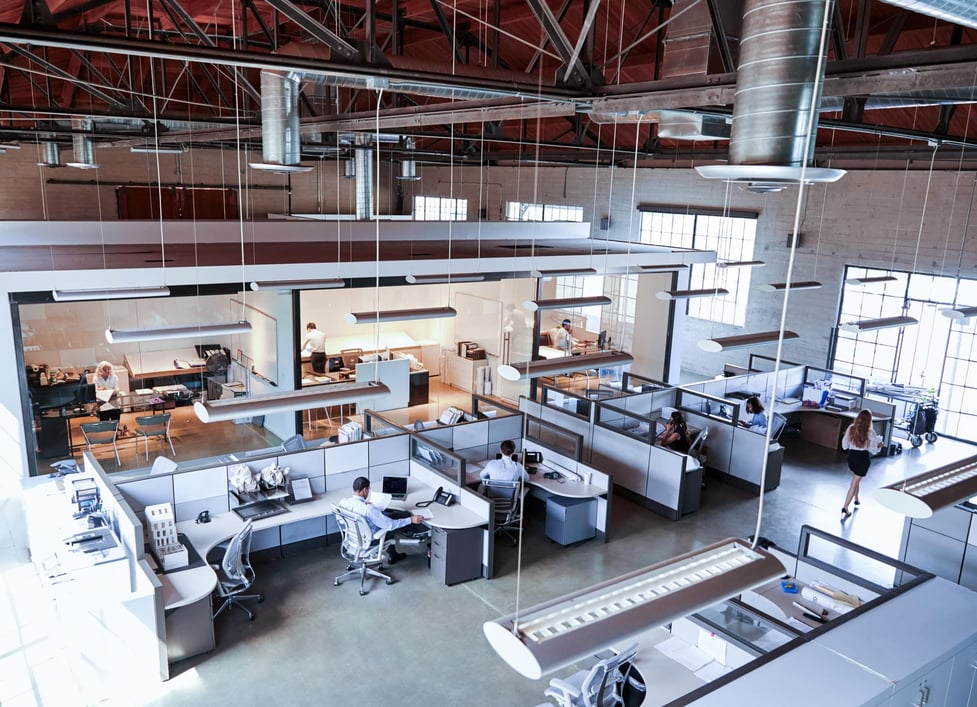How Hybrid Office Design Can Shift Mindsets
Tensions are high in the workplace. Tensions between employers and employees are growing considerably.
In the post-pandemic world, employers maintain their focus on ensuring productivity in their teams, getting the best work possible, and ensuring a ROI on their real estate.
Meanwhile, most employees in the hybrid workforce are raising concerns about a need for flexibility, and more effective workspaces and office space.
They also want a work life balance, and a want for in-person, human connection in office working.
If left unchecked, these tensions could prove detrimental to hybrid workplace conditions.
To put it simply, companies cannot afford to get this wrong.
That is why we are focusing today on highlighting how this tension can be acknowledged, how individuals relate to this tension, and how to create an amazing company culture.
 Sara Shamdani, Co-founder and Mediator at Parable Conflict Solutions, aims to bridge this divide and facilitate healthy communication across all ranks within a company.
Sara Shamdani, Co-founder and Mediator at Parable Conflict Solutions, aims to bridge this divide and facilitate healthy communication across all ranks within a company.
Her company, Parable Conflict Solutions, is focused on collaborative problem-solving, and aims to provide clients with tools and strategies to help them mitigate conflict in a healthy manner.
Utilizing conflict management is crucial as companies move forward into a post-pandemic work environment.
Employers should know how to effectively meet the needs of their employees, which can make a huge difference, and guarantee that everyone remains happy and productive.

The Pitfalls of Top-Down Decisions
Although the hybrid work model is currently popular amongst companies post-COVID, employees are expressing concerns about it creating segregation between remote and on-site staff.
The inequity primarily stems from commuting.
On-site employees believe that they have to unfairly compensate for long commute times, and balance the cost of commuting, while their remote work colleagues do not.
The need to anticipate these costs acts as a de-facto pay cut, one which employers do not have the budget to balance out.
Most businesses are under a considerable amount of pressure to ensure the hybrid office space works.
“There is an absolute need - and desire - to make the new workplace as accessible for employees as possible,” Sara notes.
“But when decisions are made unilaterally, from the top down, without any conversations from the people who are experiencing the space, it results in an increase of conflict among employees”
“When employers make unilateral decisions without making the change in a collaborative way it can exacerbate underlying problems,” Sara says.
These problems are only heightened when routine is taken into consideration, as employees become accustomed to using office environments and office space in certain ways.
For example, an individual might want to utilize a quiet conference space as a way of taking a breather for their well being when conflict arises in their team.
If management has cut that section, and it is no longer available, where can they go?
“Workers have less space to spread out,” Sara says. “And that can heighten the conflict and the tension that exists among team members.”
“We’re dealing with an information deficit because the workplace has changed,” Sara says. “And we can’t predict what will happen next. Employers need to fill the gap with data.”
The hybrid working model is new for everyone, so information is an important asset.
“The status is evolving, we need to circle back to it constantly, revisit that data, and redo the studies that we have done before to measure the change. And there needs to be constant communication… between the employers and the employees.”
This is all well and good, but who is taking this project on?
Employees are already overworked, which can be detrimental to their mental health, and figuring out solutions to hybrid office spaces is not their expertise.
Conducting these studies requires time they do not have, and tools they are unfamiliar with.
Additionally, little work has been done prior to act as a reference.
.jpg?width=964&name=iStock-1305481058%20(1).jpg)
Space Can Shift Minds
In order to solve a portion of this puzzle, companies must glean a combination of information.
Often employers aim to gain data about the happenings of their physical space first.
This is important, however it is more powerful when combined with data relating to the happenings in their employees minds.
Together, these paint a fuller picture of the problem.
This is where Sara helps to collaboratively solve a company's problem. “I'm going to pile everything together and say, based on all this data, this is what we know, this is where we can improve.”
“When you’re a pilot flying in fog, you must rely on your instruments. And that is where we are at right now: we are in a fog in terms of what is happening in terms of a hybrid workplace. Data is paramount.”
This data helps employers and employees alike understand how office space is being used.
However, it is important to understand that this data is not stagnant. It must be constantly measured and re-measured, because change is always evolving.
Similarly, indoor space should evolve over time with regards to its need and use.
“Space shifts according to people's behaviors and interactions,” says Sara. “We can create a space to drive how we think or want people to interact within it, but space is a social product.”
Over the course of its life, a room can be shaped to fit whatever needs individuals or teams have at that time.
This in and of itself is very valuable information that people should be observing.
As Sara notes: “if we aren’t watching and measuring, we’ll miss that very valuable information about what our workplaces need to be like for people to feel comfortable enough to be productive”
With Hybrid Office Space, One Size Does Not Fit All
So how do we bridge the gap between guessing and knowing what people are doing and thinking? And what does it mean for your real estate footprint?
Our indoor experiences are a defining element of our culture. But the indoors is a finite resource.
To make the most of our indoor spaces and office space, we must adapt them to the ever-changing ways people use them.
This requires the science to deeply understand our behavior indoors. Thing is, measuring indoor behavior was very difficult to do… until now.
Here at InnerSpace we have coined the term "Indoorology", which can help remove the guesswork from office planning.
Indoorology is the study of our behavior indoors. It helps us understand our interaction with indoor spaces, and informs the design of solutions which can perfect our indoor experience.
Indoorology uses InnerSpace’s proprietary technology, and like other sciences, it is based on objective data and repeatable processes.
Indoorology can help replace what we feel, with what we know.
“So much has been studied and written on space utilization and the impact of the social environment in terms of urban planning,” says Sara. “And now we’re considering it for indoor planning.”
This focus on space utilization and social environment is especially pertinent as companies continue to use the hybrid working model. However, it is important to remember that every company is different.
The physical space and social needs of one team can vary drastically compared to another.
The specific office space requirements of an engineering team and a communications team are not the same.
Indoorology can help managers ensure that their space meets the unique needs of their team, which in turn helps to foster corporate productivity and culture.
Offices need to work for everyone, because every team works differently. There is no one size fits all.
For more from Sara on how space utilization data can help you to better meet the needs of your team and increase ROI, download our latest guide.
Accurate space utilization data through Wi-Fi?
We'll prove it to you.
See why industry leaders leverage InnerSpace to generate valuable insights that go beyond occupancy.


